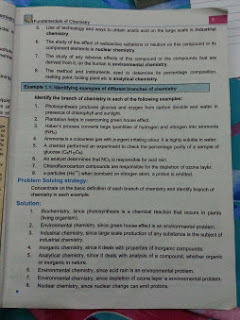FUNDAMENTALS OF CHEMISTRY LECTURE 2 | Branches of Chemistry
CHAPTER 1
FUNDAMENTALS OF CHEMISTRY LECTURE 2
Branches of Chemistry
1. Physical Chemistry
The branch of Chemistry that deals with the laws and theories to understand the structure and changes of matter is called Physical Chemistry.
2. Organic Chemistry
The branch of Chemistry that deals with substances containing carbon is called Organic Chemistry. However, some carbon compounds such as CO2, CO, carbonates and bicarbonates are studied in Inorganic Chemistry.
3. Inorganic Chemistry
The branch of Chemistry that deals with the study of all element and their compounds except organic compounds is called Inorganic Chemistry.
4. Biochemistry
The branch of Chemistry that deals with the physical and chemical changes (like Respiration, photosynthesis etc.) that occur in living organisms is called Biochemistry.
5. Industrial Chemistry
The branch of chemistry that deals with the methods and use of technology in the large scale production of useful substances is called industrial chemistry.
6. Nuclear Chemistry
The branch of Chemistry that deals with the changes that occur in atomic nuclei is called nuclear chemistry.
7. Environmental Chemistry
The branch of Chemistry that deals with the chemicals and toxic substances that pollute the environment and their adverse effect on human beings is called environmental chemistry.
8. Analytical Chemistry
The branch of Chemistry that deals with the methods and instruments that determine the composition of matter is called Analytical Chemistry.
Differentiation between branches of Chemistry
Acetic acid chemical formula: CH3COOH
Source: Vinegar which contain 5% acetic acid.
Smell: Vinegar like smell
Use: Used to flavor food.
Source: Vinegar which contain 5% acetic acid.
Smell: Vinegar like smell
Use: Used to flavor food.
Let’s see how various types of studies on this compound can help us to differentiate between the above mentioned eight branches of chemistry.
- Explanation of conversion of acetic acid from solid to liquid and liquid to gaseous state and vice versa, the application of laws and theories to understand its structure is physical chemistry.
- Since acetic acid is a carbon compound, the study of its methods of preparation and study of its physical and chemical properties is a part of organic chemistry.
- The component elements of acetic acid are carbon, hydrogen and oxygen. The study of its component elements is included in inorganic chemistry.
- The study of all chemical reactions that acetic acid undergoes in the bodies of human beings is called biochemistry.
- Use of technology and ways to obtain acetic acid on the large scale is a part of industrial chemistry.
- The study of radioactive radiation or neutron on this compound is a part of nuclear chemistry.
- The study of any adverse effects of the compound or the compounds that are derived from it, on the human is part of environmental chemistry.
- The methods and instruments used to determine its percentage composition, melting and boiling points etc is analytical chemistry.
SELF ASSESSMENT EXERCISE 1.1
Identify the branch of chemistry that is related to the following information:
- Hair contains a special class of proteins called keratins, which are present in nails and wool.
Ans: Biochemistry, since keratins are proteins that are present in living organisms.
2. Acetylene is the simplest hydrocarbon that contains carbon – carbon triple bond. Hydrocarbons are compounds of carbon and hydrogen.
Ans: Organic Chemistry, since acetylene is a hydrocarbon compound.
Ans: Organic Chemistry, since acetylene is a hydrocarbon compound.
3. White lead is a pigment used by artists for centuries, the metal Pb in the compound is extracted from its ore, galena (PbS).
Ans: Industrial Chemistry, since extraction of compounds and large scale production of any substance is the subject of Industrial chemistry.
Ans: Industrial Chemistry, since extraction of compounds and large scale production of any substance is the subject of Industrial chemistry.
4. Sulphuric acid (H2SO4) is extremely corrosive to skin.
Ans: Inorganic Chemistry, since it deals with properties of inorganic compounds.
Ans: Inorganic Chemistry, since it deals with properties of inorganic compounds.
5. Gases can be compressed by applying pressure.
Ans: Physical Chemistry, since compression of gases is the matter of physical chemistry.
Ans: Physical Chemistry, since compression of gases is the matter of physical chemistry.
6. Some examples of complete protein food are meat, milk and eggs.
Ans: Biochemistry, since compounds that are related to living organisms is studied in biochemistry.
Ans: Biochemistry, since compounds that are related to living organisms is studied in biochemistry.
7. Element radium decays by emitting a-particles and is converted into another element radon.
Ans: Nuclear Chemistry, since changes that occur in atomic nuclei is studied in nuclear chemistry.
Ans: Nuclear Chemistry, since changes that occur in atomic nuclei is studied in nuclear chemistry.
8. Calorimeter is a device that measures the amount of heat, a substance absorbs on heating or emits on cooling.
Ans: Analytical Chemistry, since it deals with the methods and instruments for determining the composition of matter.
Ans: Analytical Chemistry, since it deals with the methods and instruments for determining the composition of matter.


Comments
Post a Comment